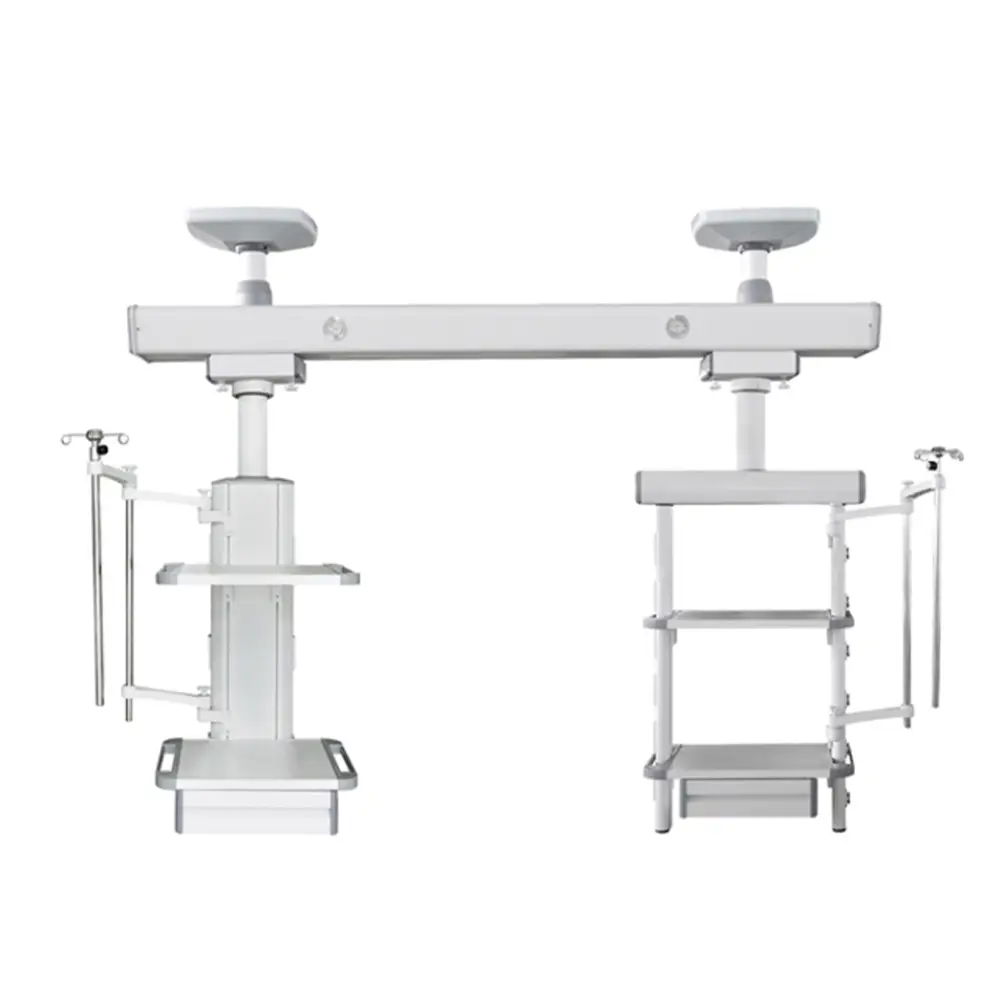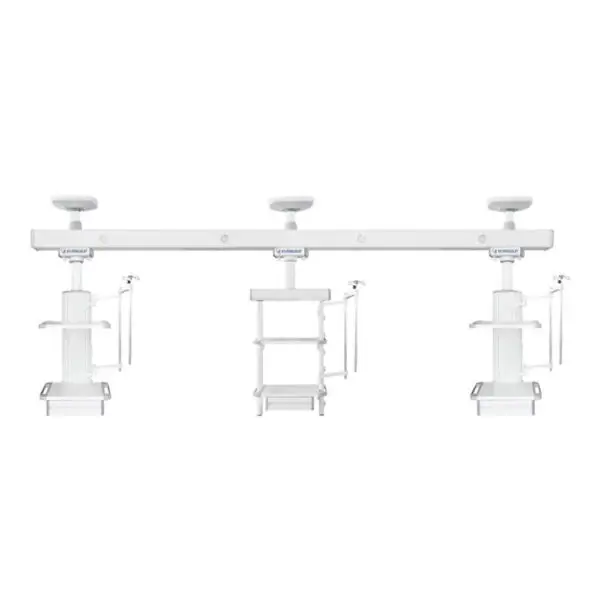Dirección
304 North Cardinal St.
Dorchester Center, MA 02124
Horas laborales
Lunes a viernes: 7:00 a. M. - 7:00 p. M.
Fin de semana: 10 a. M. - 5 p. M.
¡Bienvenido a mi blog!
Antes de profundizar en el contenido, si está interesado en nuestros productos o tiene alguna pregunta, no dude en visitar nuestra Contáctenos Página del sitio web. Nuestro equipo está listo para atenderle con consultas, pedidos o cualquier asistencia que necesite.
Ahora, comencemos nuestro viaje juntos. Espero que el contenido aquí les resulte interesante, interesante y valioso.

En un quirófano, donde cada segundo es crucial, mantener la seguridad y la eficiencia es fundamental. Los sistemas colgantes de quirófano se han vuelto indispensables para lograr estos objetivos. Estos sistemas de techo están diseñados para gestionar equipos médicos, iluminación y gases, a la vez que reducen el desorden y mantienen todo organizado. Al garantizar que las herramientas críticas estén al alcance de la mano, mejoran la seguridad y el flujo de trabajo de las cirugías.
Este artículo explora el papel fundamental que desempeñan los sistemas colgantes de cirugía en la mejora de la seguridad quirúrgica, desde la reducción de errores hasta la optimización de la eficiencia del quirófano. Examinaremos cómo estos sistemas ayudan a optimizar los procesos, mantener entornos estériles y facilitar una experiencia quirúrgica fluida y segura tanto para los pacientes como para los profesionales médicos.
La precisión quirúrgica es uno de los factores más importantes para obtener resultados exitosos. Los monitores colgantes médicos contribuyen a ello, garantizando que todas las herramientas, monitores y equipos estén organizados y sean fácilmente accesibles. Con todo correctamente organizado, los cirujanos pueden concentrarse por completo en el procedimiento, evitando las distracciones de buscar instrumentos o lidiar con configuraciones desorganizadas.
Los colgantes permiten colocar el equipo quirúrgico exactamente donde se necesita, reduciendo el tiempo dedicado a ajustar las herramientas durante el procedimiento. En situaciones de alta presión, como las cirugías mínimamente invasivas, esto es especialmente importante, ya que los movimientos del cirujano suelen estar restringidos y cada acción debe ser deliberada y precisa.
Al mantener el espacio de trabajo ordenado y brindar acceso ajustable a las herramientas necesarias, los colgantes mejoran significativamente la precisión de la cirugía, lo que en última instancia beneficia el resultado del paciente.
La contaminación cruzada es una preocupación importante en cualquier entorno médico, y los quirófanos no son la excepción. Los dispositivos colgantes quirúrgicos ayudan a mitigar este riesgo al elevar el equipo del suelo y alejarlo de posibles fuentes de contaminación. Con los dispositivos médicos suspendidos sobre el campo estéril, se reduce considerablemente la probabilidad de que los contaminantes se transfieran de las superficies a las herramientas.
La organización que proporcionan los colgantes quirúrgicos también contribuye a la prevención de infecciones. Al mantener los instrumentos y equipos adecuadamente separados y fácilmente accesibles, los equipos quirúrgicos son menos propensos a cometer el error común de tocar o manipular incorrectamente los artículos estériles. Esta mejor organización facilita la desinfección rápida y exhaustiva del equipo, lo que reduce aún más el riesgo de infección.
Al ofrecer un medio simple pero eficaz para mantener el quirófano ordenado y estéril, los colgantes quirúrgicos médicos son una herramienta clave para controlar la propagación de patógenos durante la cirugía.

El control de infecciones es una de las prioridades más importantes en cualquier cirugía. Los colgantes quirúrgicos ayudan a reducir el riesgo de infecciones al organizar el equipo de forma que se elimina la necesidad de colocar objetos en el suelo que puedan acumular suciedad, polvo y bacterias. Elevar el equipo del suelo facilita el mantenimiento de un entorno limpio y estéril.
Además, las superficies lisas y fáciles de limpiar del colgante permiten una rápida desinfección entre cirugías, lo que garantiza que los patógenos dañinos no permanezcan en el equipo ni en el quirófano. Con los colgantes quirúrgicos médicos, la organización del equipo no solo mejora la eficiencia, sino que también contribuye a un mayor control de infecciones al permitir una limpieza y esterilización más exhaustiva de la sala y el instrumental.
Este enfoque sistemático de la limpieza desempeña un papel fundamental en la reducción de las infecciones posoperatorias, garantizando en última instancia la seguridad del paciente y mejorando los resultados quirúrgicos.
Uno de los desafíos más comunes en un quirófano es la gestión de los numerosos cables, dispositivos y líneas de gas que alimentan los equipos médicos. Sin un sistema eficiente, los equipos pueden enredarse, interferir entre sí o incluso caerse accidentalmente. Los colgantes quirúrgicos médicos resuelven este problema al proporcionar un espacio fijo y elevado para todas las herramientas y dispositivos necesarios, manteniendo los cables y las líneas de gas médico separados entre sí y del campo estéril.
El diseño de la mayoría de los colgantes permite un fácil ajuste, asegurando que cada pieza del equipo esté colocada óptimamente para el procedimiento quirúrgico. Esto significa que los dispositivos no se estorbarán entre sí y se reduce el riesgo de fallos o interferencias. Esta mayor organización también evita movimientos innecesarios, permitiendo al equipo quirúrgico concentrarse en la tarea en cuestión en lugar de lidiar con cables enredados o instrumental extraviado.
Al minimizar el riesgo de interferencia, los colgantes quirúrgicos médicos mejoran la eficiencia y la seguridad de la sala de operaciones, lo que facilita que el equipo quirúrgico trabaje de manera eficaz y sin distracciones.
La cirugía mínimamente invasiva requiere una planificación cuidadosa y precisión debido al espacio y el acceso limitados. Aquí es donde los colgantes quirúrgicos médicos pueden marcar una diferencia significativa. Al elevar equipos críticos como monitores, iluminación y dispositivos de succión, los colgantes ayudan a mantener la mesa de operaciones despejada y accesible, permitiendo al cirujano operar sin obstrucciones.
Los colgantes también garantizan que el equipo necesario para la cirugía mínimamente invasiva esté al alcance de la mano, lo que reduce el tiempo dedicado a ajustar o recuperar herramientas. Dado que el espacio disponible para el equipo en estos procedimientos es mínimo, la flexibilidad de posicionamiento del colgante garantiza el acceso a todas las herramientas y dispositivos necesarios sin afectar la delicada zona quirúrgica.
Este mayor espacio y accesibilidad permite que el equipo quirúrgico se concentre completamente en el procedimiento, mejorando tanto la seguridad de la cirugía como los resultados para el paciente.

Los errores quirúrgicos pueden tener consecuencias devastadoras, y muchos se deben a una mala organización, la falta de instrumentos o procedimientos apresurados. Los colgantes quirúrgicos médicos están diseñados para combatir estos riesgos, agilizando el proceso quirúrgico. Con todos los instrumentos, herramientas y dispositivos médicos organizados y fácilmente accesibles, el riesgo de perder una herramienta o usar la incorrecta se reduce significativamente.
La capacidad del colgante para mantener el equipo ubicado exactamente donde se necesita también minimiza la necesidad de que los equipos quirúrgicos se desplacen o busquen artículos, lo que les ayuda a concentrarse en el procedimiento. La posibilidad de ajustar y reposicionar el equipo durante la cirugía garantiza que todo esté al alcance del equipo quirúrgico, evitando retrasos o errores innecesarios.
De esta manera, los colgantes quirúrgicos médicos contribuyen directamente a reducir el error humano, garantizando que los procedimientos se desarrollen sin problemas y de forma segura y, en última instancia, mejorando los resultados de los pacientes.
Con el auge de la cirugía asistida por robot, la necesidad de contar con equipos eficientes y organizados es más crucial que nunca. Los colgantes quirúrgicos desempeñan un papel fundamental en el soporte de los sistemas robóticos, proporcionando un lugar seguro y organizado para los brazos robóticos, los monitores y otros equipos esenciales. Al centralizar todas las herramientas robóticas, el colgante garantiza que todo lo necesario para el procedimiento esté al alcance de la mano.
Esto es especialmente importante en la cirugía robótica, donde el control y la sincronización precisos son vitales. La capacidad de ajustar y posicionar el control remoto garantiza que los instrumentos, las luces y los monitores robóticos estén siempre en la posición óptima para el equipo quirúrgico. La disposición organizada del control remoto también ayuda a reducir el riesgo de interferencias entre los dispositivos robóticos y otros equipos, garantizando un funcionamiento fluido durante todo el procedimiento.
Además de apoyar la cirugía robótica, los colgantes también brindan flexibilidad al equipo quirúrgico para mover y ajustar las herramientas robóticas según sea necesario, lo que garantiza el éxito de estas cirugías de alta precisión.
En una emergencia, el tiempo es crucial. Los colgantes médicos quirúrgicos ayudan a mejorar la preparación para emergencias al garantizar que todas las herramientas y equipos necesarios estén organizados y sean fácilmente accesibles. Al mantener todo en una ubicación central, el colgante garantiza que el personal quirúrgico pueda acceder a las herramientas esenciales sin perder tiempo buscando o reorganizando el equipo.
Esta rápida accesibilidad es crucial cuando el tiempo apremia, como en cirugías de trauma o procedimientos urgentes. La capacidad de acceder rápidamente al equipo desde un sistema colgante puede marcar la diferencia entre la vida y la muerte en situaciones críticas. Al reducir el tiempo dedicado a la recuperación del equipo, los colgantes mejoran la velocidad y la eficiencia de las cirugías de emergencia, garantizando los mejores resultados posibles para el paciente.
Al elegir un colgante médico quirúrgico, es fundamental considerar su capacidad de carga. El colgante debe ser capaz de soportar todo el equipo que contendrá, como lámparas, monitores, máquinas de anestesia y otros dispositivos. Exceder la capacidad de carga puede provocar una falla del sistema, lo que podría interrumpir la cirugía y representar riesgos de seguridad.
Al seleccionar un soporte colgante con la capacidad de carga adecuada, los centros médicos pueden garantizar la seguridad y estabilidad de sus equipos durante su uso. La capacidad del soporte colgante debe ser acorde con el peso de las herramientas y dispositivos que soportará, lo que ayuda a evitar accidentes y garantiza un funcionamiento fluido e ininterrumpido.

Elegir el sistema de suspensión quirúrgica adecuado implica más que simplemente seleccionar uno que se adapte a su quirófano. Requiere evaluar los tipos de cirugías que realiza, el equipo que utilizará y la distribución del quirófano. Un buen sistema de suspensión debe acomodar todos sus equipos, desde gases medicinales hasta conexiones eléctricas, y ser lo suficientemente flexible como para adaptarse a sus necesidades.
También es importante buscar características como diseños modulares y alturas ajustables. Estas características permiten personalizar la suspensión para adaptarla a las necesidades específicas de su centro, garantizando su utilidad y eficiencia durante años. Invertir en un sistema de suspensión versátil y de alta calidad resultará rentable a largo plazo, ya que contribuirá a cirugías más seguras y mejorará la eficiencia del quirófano.
Colgantes médicos quirúrgicos Son herramientas esenciales que mejoran la seguridad, la eficiencia y la organización de los quirófanos. Desde mejorar la precisión y minimizar errores hasta apoyar técnicas quirúrgicas avanzadas como la robótica, los colgantes ofrecen numerosas ventajas. Ayudan a mantener un entorno limpio y organizado que reduce la contaminación cruzada y facilita un mejor control de infecciones. En definitiva, los colgantes quirúrgicos médicos contribuyen a mejores resultados para los pacientes y a cirugías más seguras, lo que los convierte en un componente indispensable de los quirófanos modernos.
¿Cómo mejora un colgante quirúrgico médico la seguridad quirúrgica?
Al organizar el equipo y brindar un fácil acceso, los colgantes quirúrgicos médicos reducen el riesgo de errores y garantizan un entorno estéril y eficiente.
Poder colgantes médicos quirúrgicos ¿Apoyas equipos de cirugía robótica?
Sí, están diseñados para albergar diversos equipos, incluidos sistemas robóticos, garantizando que todas las herramientas estén organizadas y accesibles.
¿Los colgantes quirúrgicos médicos son personalizables para diferentes tipos de cirugías?
Sí, los colgantes quirúrgicos médicos vienen en diseños modulares que se pueden personalizar para adaptarse a las necesidades específicas de diferentes procedimientos quirúrgicos.
